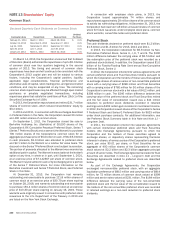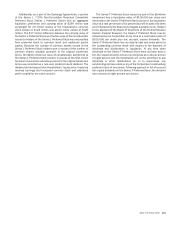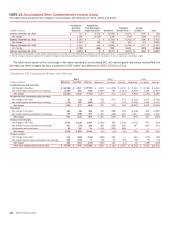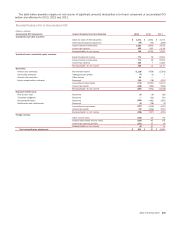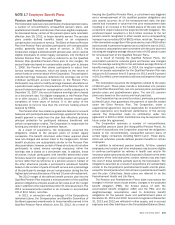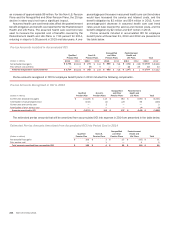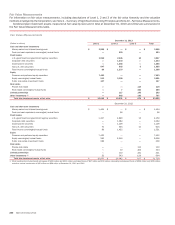Bank of America 2013 Annual Report Download - page 239
Download and view the complete annual report
Please find page 239 of the 2013 Bank of America annual report below. You can navigate through the pages in the report by either clicking on the pages listed below, or by using the keyword search tool below to find specific information within the annual report.Bank of America 2013 237
NOTE 16 Regulatory Requirements and
Restrictions
The Corporation manages regulatory capital to adhere to internal
capital guidelines and regulatory standards of capital adequacy
based on its current understanding of the rules and the application
of such rules to its business as currently conducted.
The Federal Reserve, Office of the Comptroller of the Currency
(OCC) and FDIC (collectively, joint agencies) establish regulatory
capital guidelines for U.S. banking organizations. The regulatory
capital guidelines measure capital in relation to the credit and
market risks of both on- and off-balance sheet items using various
risk weights. Under the current regulatory capital guidelines, Total
capital consists of three tiers of capital. Tier 1 capital includes
the sum of “core capital elements,” the principal components of
which are qualifying common shareholders’ equity and qualifying
non-cumulative perpetual preferred stock. Also included in Tier 1
capital are qualifying trust preferred securities (Trust Securities),
hybrid securities and qualifying noncontrolling interests in
subsidiaries which are subject to the rules governing “restricted
core capital elements.” Goodwill, other disallowed intangible
assets, disallowed deferred tax assets and the cumulative
changes in fair value of all financial liabilities accounted for under
the fair value option that are included in retained earnings and are
attributable to changes in the company’s own creditworthiness are
excluded from the sum of core capital elements. Tier 2 capital
consists of qualifying subordinated debt, a limited portion of the
allowance for loan and lease losses, a portion of net unrealized
gains on AFS marketable equity securities and other adjustments.
The Corporation’s total capital is the total of Tier 1 capital plus
supplementary Tier 2 capital. Tier 3 capital includes subordinated
debt that is unsecured, fully paid, has an original maturity of at
least two years, is not redeemable before maturity without prior
approval by the Federal Reserve and includes a lock-in clause
precluding payment of either interest or principal if the payment
would cause the issuing bank’s risk-based capital ratio to fall or
remain below the required minimum. Tier 3 capital can only be
used to satisfy the Corporation’s market risk capital requirement
and may not be used to support its credit risk requirement. At
December 31, 2013 and 2012, the Corporation had no
subordinated debt that qualified as Tier 3 capital.
To meet minimum, adequately capitalized regulatory
requirements, an institution must maintain a Tier 1 capital ratio
of four percent and a Total capital ratio of eight percent. A “well-
capitalized” institution must generally maintain capital ratios
200 bps higher than the minimum guidelines. The risk-based
capital rules have been further supplemented by a Tier 1 leverage
ratio, defined as Tier 1 capital divided by quarterly average total
assets, after certain adjustments. Bank holding companies (BHCs)
must have a minimum Tier 1 leverage ratio of at least four percent.
National banks must maintain a Tier 1 leverage ratio of at least
five percent to be classified as “well-capitalized.” Failure to meet
the capital requirements established by the joint agencies can
lead to certain mandatory and discretionary actions by regulators
that could have a material adverse effect on the Corporation’s
financial position. At December 31, 2013, the Corporation’s Tier
1 capital, Total capital and Tier 1 leverage ratios were 12.44
percent, 15.44 percent and 7.86 percent, respectively.
Current guidelines restrict certain core capital elements to 15
percent of total core capital elements for internationally active
BHCs. Internationally active BHCs are those that have significant
activities in non-U.S. markets with consolidated assets greater
than $250 billion or on-balance sheet non-U.S. exposure greater
than $10 billion, which includes the Corporation. In addition, the
Federal Reserve revised the qualitative standards for capital
instruments included in regulatory capital. At December 31, 2013,
the Corporation’s restricted core capital elements comprised 3.3
percent of total core capital elements. The Corporation is in
compliance with the revised guidelines.
Tier 1 common capital is not an official regulatory ratio, but was
introduced by the Federal Reserve during the Supervisory Capital
Assessment Program in 2009. Tier 1 common capital is Tier 1
capital less preferred stock, Trust Securities, hybrid securities and
qualifying noncontrolling interests in subsidiaries. The
Corporation’s Tier 1 common capital was $145.2 billion and the
Tier 1 common capital ratio was 11.19 percent at December 31,
2013.





